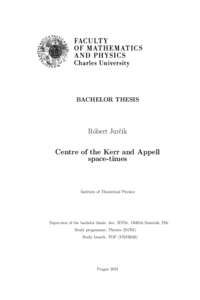Centre of the Kerr and Appell space-times
Centrum Kerrova a Appellova prostoročasu
bakalářská práce (OBHÁJENO)

Zobrazit/
Trvalý odkaz
http://hdl.handle.net/20.500.11956/149190Identifikátory
SIS: 216339
Kolekce
- Kvalifikační práce [11973]
Autor
Vedoucí práce
Oponent práce
Žofka, Martin
Fakulta / součást
Matematicko-fyzikální fakulta
Obor
Obecná fyzika
Katedra / ústav / klinika
Ústav teoretické fyziky
Datum obhajoby
14. 9. 2021
Nakladatel
Univerzita Karlova, Matematicko-fyzikální fakultaJazyk
Angličtina
Známka
Výborně
Klíčová slova (česky)
obecná relativita|geometrie prostoročasu|Kerrova metrikaKlíčová slova (anglicky)
general relativity|geometry of space-time|Kerr metricJedným z najdôležitejších riešení Einsteinových rovníc je Kerrova metrika. V samot- nom strede tohto časopriestoru leží krivostná prstencová singularita. Táto singularita uzatvára povrch, ktorý spája dve asymptoticky ploché časti variety. Povrch je vnútorne plochý a štandardne sa interpretuje ako rovinný disk. Nedávno však bol publikovaný článok, ktorý tvrdí, že centrálny povrch je v skutočnosti dvojkužel s vrcholmi na ose symetrie. V tejto práci analyzujeme rôzne geometrické charakteristiky povrchu, aby sme zistili, ktorý z obrázkov je adekvátnejší. Skúmame tiež rovnaký povrch v Appellovom časopriestore, ktorý má rovnakú priestorovú štruktúru ako Kerrov prostoročas. 1
One of the most important solutions of Einstein equations is the Kerr metric. At the very centre of this space-time, there lies a ring curvature singularity. The singularity encircles a surface which joins together two asymptotically flat sheets of the manifold. The surface is intrinsically flat and is standardly interpreted as a planar disc. However, an article has been recently published which claims that the central surface is actually a dicone, with vertex (vertices) on the symmetry axis. In this thesis we analyse various geometric characteristics of the surface, in order to check which of the pictures is more adequate. We also examine the same surface of the Appell space-time which has the same spatial structure as the Kerr one. 1
